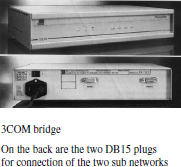Chapter 5
Interconnection by Bridges: The Spanning Tree Algorithm

In this chapter we will describe the interconnection between the IEEE 802.3 network and Ethernet network.
5.1. Introduction

By convention, the term bridge designates equipment implementing an ISO level-2 model interconnection. A bridge thus works at the frame level. To be of any use, it needs to be connected to at least to two subnets (see Figure 5.1). A bridge functioning principle is, in broad terms, relatively simple:
— The bridge listens to all activity (i.e. all circulating frames) on all subnets; this mode is called “promiscuous”;
— It stores frames selected according to criteria in its memory, which are detailed later on in this chapter;
— It retransmits the messages stored in memory towards other subnet(s).
A bridge does not need a MAC address to function1. It is called transparent. The bridge recopies some frames in its memory that reach it. For transmission, the bridge acts as an ordinary station on the network, except that it does not modify the source MAC address inside the frame. Its presence cannot be detected. The only difference is the increase in propagation delays due to the complete frame storage in the bridge memory and in the access time to other subnets.
Figure 5.1. Simple bridge network ...
Get Local Networks and the Internet: From Protocols to Interconnection now with the O’Reilly learning platform.
O’Reilly members experience books, live events, courses curated by job role, and more from O’Reilly and nearly 200 top publishers.

